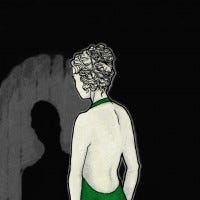Emily Short examines storytelling in Gamelab's Jojo's Fashion Show 2, looking at all the intriguing ways the casual fashion gameplay is supported by its surprising story.

[Emily Short regularly examines storytelling and narrative in games of all flavors, including the casual, indie, and obscurely hobbyist. This week she looks at Jojo's Fashion Show 2, by Gamelab -- and finds the story in strong support of the gameplay.] Jojo's Fashion Show 2 starts off with an obvious handicap, viz. being a numbered sequel. Reviews focused on the repetition and lack of technical innovation from the first installment in the series, and I would have to agree that those are fair complaints. Several things make it stand out, though. First, the writing is unusually perky for a casual game. I would have said "surprisingly", but in fact this does not surprise me, since several of the people working on this project also worked on Gamelab's Miss Management, a piece so successfully written that I still remember the major characters with amusement and rueful affection many months after playing. The characters in Jojo's Fashion Show 2 aren't quite such a bundle of neuroses, but they are unusually distinct and opinionated. Jojo also affords a rather larger cast than the average frame-story cast in a casual game. The Diner Dash episodes usually get by with Flo, Quinn, and other cookie-cutter gal pals assembled from various Dash variations, with perhaps Flo's grandma thrown in for color; but I'd have a hard time naming any way in which Flo and Quinn differ in personality (for instance), and adding more members to their posse would just make it bigger, not more interesting. Besides which, Flo has become such a franchise that we can be safely assured nothing remotely interesting will ever happen to her again. Jojo's Fashion Show 2 does borrow a few popular stereotypes in order to distinguish its characters -- the fashion magazine editor courtesy of The Devil Wears Prada being the most obvious. They've even given her Meryl Streep's hair, lest there be any question about the intended casting. Nonetheless, there are more distinct personae, and they're more fun, than you'll see in any other game of the same ilk. Second, there's a plot that involves conflict between characters, and this time it's not just a simplistic struggle against some greedy or envious villain, but a considerably more plausible and more engaging conflict between people who care about one another. The mother/daughter team of Jojo and Ros generates some creative tension, which leads to an argument and a parting of ways. This is all handled with a fair degree of sensitivity: the player can see the crash coming a little way in advance, but it still has a little sting. And once it has happened, the two of them are left to struggle on without each other for a while. There are subplots, too -- a romance, an old rivalry going through new stages -- but the story stays most focused on what the designers rightly knew was the most interesting arc, the resolution of differences between Jojo and her daughter. Finally, the gameplay reflects all of these stages, with inventive level design that lets the player experience and share in the struggles of the main characters. It helps that the play concept of dressing models to fit a specific style lends itself to a lot of tuning: the game has many variables to play with: what styles the player is trying for; how much time is allowed per model; what pieces are available and how suitable they are, on average, for the target styles; how many times the player is permitted to refresh the wardrobe with new clothes; etc. Scores are based on how well each piece of clothing matches the criteria of the given style, with some extra bonuses for effective combinations (like jeans with a t-shirt, or boots with a mid-length skirt). When Rosalind and Jojo of them are feeling out of sync, the player may be confronted with hard-to-reconcile style challenges; for instance, during one of the most stressful points in their collaboration, I found myself trying to create flapper ensembles and casual business ensembles at the same time, where the difficulty is that very few pieces are suitable for both. I was constantly getting stuck with a business woman to dress and a wardrobe full of fringed skirts, or the reverse, and found myself burning through my bonuses to recycle the available clothes, irritated by the incompatibilities. Then they separate, and the player has the chance to dress shows for each of them individually. Ros, on her own, experiments with some wacky style ideas that become more challenging for the player to throw together on instinct -- requiring more thought and more frequent reference to the style guides to make sure one is on the right track.  When Jojo is lonely, on the other hand, she becomes depressed and her creativity evaporates. Her styles become very simple and predictable, so there are few criteria to match, which means that no one element of an ensemble is ever worth very many points. This leaves the player frantically working the chaining bonuses in an attempt to get decent scores out of uninspired outfit concepts. The game tunes the player's frustration to match up with what the characters feel -- and frustration is one emotion that games are reliably good at provoking. And when at last mother and daughter are reconciled (I didn't say the plot was unpredictable), their new style concepts are silly, exuberant, and hugely fun to play with. This gives the game a kick of exciting new life. The player gets new and ever-more-fanciful pieces of clothing, and the target styles are more closely aligned. (It's particularly easy to dress the show which includes both Punk and its bizarre relative Flamenco Punk, since there's such a large supply of crossover pieces.) At the same time, the player finds himself working against a faster clock and with higher point-value expectations. The result is the sensation of being a bit stressed by the higher stakes, but finally in sync over the process -- exactly where the story has taken the characters at this point. This is strong design. I imagine it requires that the writers be intimately part of the level design process from the outset, because someone on the team must be asking not just "what new challenges can we put into this level to make it more interesting?" but "how will these new challenges shape the experience of play, and how can we line that up with what is happening in the story?" It makes a huge difference. Jojo's Fashion Show 2 is still definitely using story in support of game, rather than vice versa. The main attraction of play is the semi-zen state one gets into while assembling outfit upon outfit, and the narrative arc is not as dominant as it was in Miss Management. Nonetheless, Gamelab continues to do a better job than most at presenting character experience through the gameplay, drawing the player into sympathy with their emotional states and struggles. I continue to find theirs some of the best casual game writing on the market. [Emily Short is an interactive fiction author and part of the team behind Inform 7, a language for IF creation. She also maintains a blog on interactive fiction and related topics. She can be reached at emshort AT mindspring DOT com.]
When Jojo is lonely, on the other hand, she becomes depressed and her creativity evaporates. Her styles become very simple and predictable, so there are few criteria to match, which means that no one element of an ensemble is ever worth very many points. This leaves the player frantically working the chaining bonuses in an attempt to get decent scores out of uninspired outfit concepts. The game tunes the player's frustration to match up with what the characters feel -- and frustration is one emotion that games are reliably good at provoking. And when at last mother and daughter are reconciled (I didn't say the plot was unpredictable), their new style concepts are silly, exuberant, and hugely fun to play with. This gives the game a kick of exciting new life. The player gets new and ever-more-fanciful pieces of clothing, and the target styles are more closely aligned. (It's particularly easy to dress the show which includes both Punk and its bizarre relative Flamenco Punk, since there's such a large supply of crossover pieces.) At the same time, the player finds himself working against a faster clock and with higher point-value expectations. The result is the sensation of being a bit stressed by the higher stakes, but finally in sync over the process -- exactly where the story has taken the characters at this point. This is strong design. I imagine it requires that the writers be intimately part of the level design process from the outset, because someone on the team must be asking not just "what new challenges can we put into this level to make it more interesting?" but "how will these new challenges shape the experience of play, and how can we line that up with what is happening in the story?" It makes a huge difference. Jojo's Fashion Show 2 is still definitely using story in support of game, rather than vice versa. The main attraction of play is the semi-zen state one gets into while assembling outfit upon outfit, and the narrative arc is not as dominant as it was in Miss Management. Nonetheless, Gamelab continues to do a better job than most at presenting character experience through the gameplay, drawing the player into sympathy with their emotional states and struggles. I continue to find theirs some of the best casual game writing on the market. [Emily Short is an interactive fiction author and part of the team behind Inform 7, a language for IF creation. She also maintains a blog on interactive fiction and related topics. She can be reached at emshort AT mindspring DOT com.]
About the Author(s)
You May Also Like








